
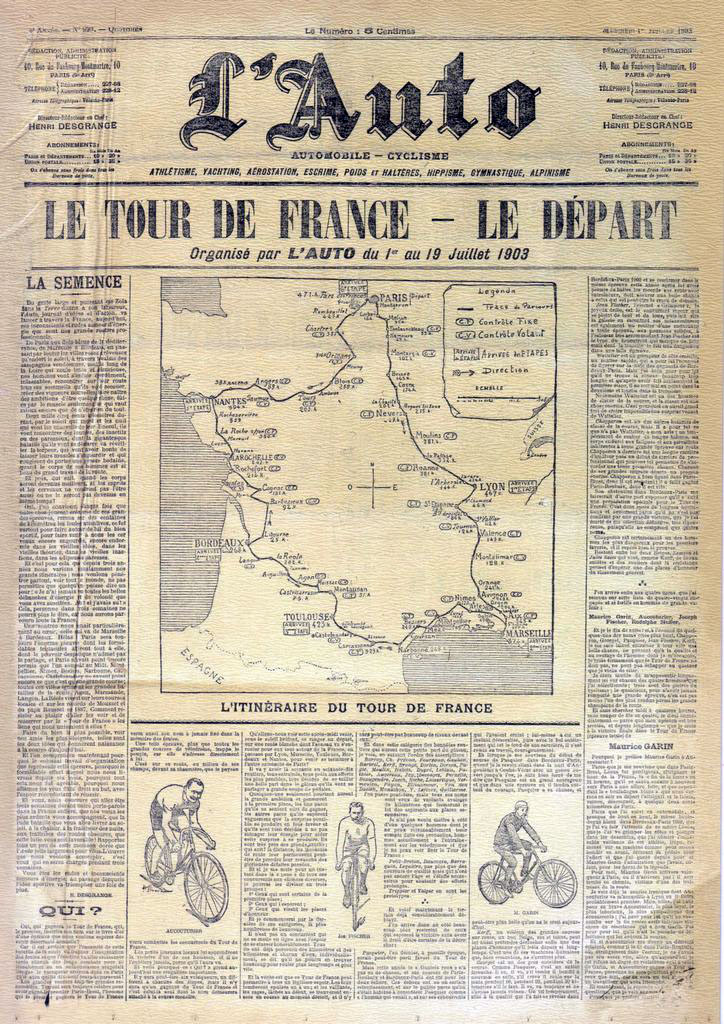
The 2013 Tour de France marks the 100th of the event’s history, which began in 1903 (the competition was put on hold during the two world wars). Strangely, this inaugural event of 1903 had it’s origins in one of France’s greatest political scandals – the Dreyfuss Affair. In 1894 a young French artillery officer of Jewish descent, Captain Alfred Dreyfus, was convicted of high treason but then, years later, was proven to be innocent in the light of new evidence, evidence which the military attempted to suppress. The ensuing debate over Dreyfuss’ innocence, and the wider issues of anti-semitism in which it was embedded, divided the nation. One such division occurred within France’s most popular cycling magazine L’Velo, causing it to split into two when an anti-Dreyfuss contingent broke away to form L’Auto-Velo. L’Velo‘s owner won a court case forcing L’Auto-Velo to change their name, which they did, to L’Auto, a move which saw their sales subsequently plummet. In an effort to boost their waning popularity, and win back their cycling fans, L’Auto set up the Tour de France in 1903. It was a hugely successful campaign which caused their sales to increase 6-fold during and after the race and, eventually, pushed L’Velo into bankruptcy.
The 1903 competition was run only in six fairly flat stages, unlike the mountainous 21 stage event it would grow to become, however, each of these 1903 stages were extraordinarily long, with an average distance of over 400 km (250 mi), more than double the distance of today’s. 60 cyclists, all professionals or semi-professionals, started the race, of whom 49 were French, 4 Belgian, 4 Swiss, 2 German, and one was Italian, Maurice Garin, the pre-race favourite who eventually went on to win the event. Garin would go onto also win the next year’s race only to then be disqualified along with eight other riders for cheating including the illegal use of cars and trains.

MASSEUR, MAURICE GARIN, & SON
Maurice Garin achieved everlasting fame as the winner of the first Tour de France.
The Tour de France was created in 1903 as an indirect result of one of France’s most notorious political scandals, the Dreyfuss Affair, which divided the entire nation.
The newspaper with the largest circulation in France was Le Velo, selling 80,000 copies a day. However, some of Le Vélo‘s advertisers disagreed with the paper’s support for Alfred Dreyfuss, a Jewish soldier scandalously found guilty of selling secrets to the Germans, but eventually acquitted after being sent to Devil’s Island.
The Tour de France was started in order to promote a new daily sports newspaper, L’Auto, established by the anti-Jewish lobby in the wake of the Dreyfus Affair. The editor, Henri Desrange, planned a five-week race from 31 May to 5 July. This proved too daunting and only 15 entered, so Desgrange cut the length to 19 days and offered a daily allowance.
The race began at the Au Reveil Matin café at a crossroads in Montgeron, south of Paris, and ended in Ville-d’Avray, another suburb, having circuited France in six days of racing over 2,428 km. One stage, between Nantes and Paris, was 471 km. Sixty riders started, at an entry fee of 10 francs, and 21 finished.
Maurice Garin, riding a La Francaise Diamant machine, won 3,000 francs for finishing first in 94h 33m 14s (making a total of 6,125 francs with his other prizes). Lucien Pothier was second and Fernand Augereau third.
Pierre Chany wrote: In the town which adopted Maurice Garin, at Lens, an immense procession was organised with the participation of all the notables of the region. Before leaving Paris on Monday evening, the day after the race finished, the winner paid a visit, out of politeness, to Henri Desgrange and, in a gesture without precedent, pulled a sheet of paper from his pocket. It was an article in order to simplify the interview, he explained! There he gave his feelings during the race, gave his opinion on the formula by which the race was run, gave a word of congratulation to his rivals. Garin’s written note said:
The 2,500km that I’ve just ridden seem a long line, grey and monotonous, where nothing stood out from anything else. But I suffered on the road. I was hungry, I was thirsty, I was sleepy, I suffered, I cried between Lyon and Marseille, I had the pride of winning other stages, and at the controls I saw the fine figure of my friend Delattre, who had prepared my sustenance, but I repeat, nothing strikes me particularly.
But wait! I’m completely wrong when I say that nothing strikes me. I’m confusing things or explaining myself badly. I must say that line single thing struck me, that a single thing sticks in my memory: I see myself, from the start of the Tour de France, like a bull pierced by banderillas, who pulls the banderillas with him, never able to rid himself of them.


c1900 Unknown French frame-set, now sold and being restored by its new owner


SOCIETE GARIN et BERNAUX
17 boulevard de Paris, Roubaix, France

The early Roubaix company was started by Maurice and his brothers, which went out of business in 1900. His brothers François and César opened a cycle shop with Maurice in the lower end of the boulevard de Paris in Roubaix in 1895.
His brother Cesar (16 December 1879, Arviers – 27 March 1951) also competed as a professional cyclist from 1899-1906, and lived in Paris (Seine) until his death at the age of 71. His best results were: Roubaix – Bray-Dunes 1899 3rd; Paris-Roubaix 1904 2nd; Tour de France, 1904 2nd on Stage 5 to Nantes.
Another brother Ambroise (10 May 1875, Arviers – 31 March 1969) also competed as a professional cyclist from 1899-1903, and lived at Val-d’Oise until his death at the age of 93. His best results were: Paris-Roubaix 1899 3rd, 1901 2nd, 1902 3rd; Bordeaux-Paris 1900 3rd, 1902 3rd.

MAURICE GARIN: RACING HISTORY

1892: Maurice Garin began racing in northern France aged 21, in 1892, when the secretary of the cycling club at Maubeuge persuaded him to enter a regional race, over 200 km. Garin finished fifth despite suffering from the sun and decided to ride more.
1893: His first win was in 1893, in Namur-Dinant-Givet in Belgium. He had sold his first bike and bought a lighter one — still 16 kg but with pneumatic tyres — for 850 old French francs. The race was over 102 km. He was leading by Dinant when he punctured. Spotting a soigneur waiting with a spare bike for a rival, Garin rested his own against the wall of a bridge, grabbed the soigneur’s spare bike and rode off. At the finish, winning with 10 minutes over the field, he gave back the bike and recovered his own the next day where he had left it.
1893: Garin became a professional by chance. He planned to ride a race at Avesnes-sur-Helpes, 25 km from where he lived. He arrived to find it was only for professionals. Not allowed to compete, he waited until the riders had left, raced after them and passed them all. He fell off twice but finished ahead of the racers. The crowd was enthusiastic but the organisers less so. They refused to pay him the 150 francs due to the real winner, so spectators raised 300 francs among themselves. Garin became a professional.
His first true professional win was in a 24-hour race in Paris in 1893. It was held on the Champ de Mars, site of the Eiffel Tower. The riders competed, as was the custom, behind a succession of pacers. The event took place in February and the cold drove out riders one after the other. Garin rode 701 km in 24 hours, beating the only other rider to finish by 49 km.
1894: He won a 24-hour race in Liege, Belgium.
1895: He set a one hour record for cycling behind pacers.
1896: The first Paris-Roubaix was in 1896; Garin came third, 15 minutes behind Josef Fischer. He would have come second had he not been knocked over by a crash between two tandems, one of them ridden by his pacers. Garin ‘finished exhausted and Dr Butrille was obliged to attend the man who had been run over by two machines,’ said the race historian, Pascal Sergent.
1897: This year he won Paris–Roubaix, beating the Dutchman Mathieu Cordang in the last two kilometres of the velodrome at Roubaix. Sergent said:
As the two champions appeared they were greeted by a frenzy of excitement and everyone was on their feet to acclaim the two heroes. It was difficult to recognise them. Garin was first, followed by the mud-soaked figure of Cordang. Suddenly, to the stupefaction of everyone, Cordang slipped and fell on the velodrome’s cement surface. Garin could not believe his luck. By the time Cordang was back on his bike, he had lost 100 metres. There remained six laps to cover. Two miserable kilometres in which to catch Garin. The crowd held its breath as they watched the incredible pursuit match. The bell rang out. One lap, there remained one lap. 333 metres for Garin, who had a lead of 30 metres on the Batave.
A classic victory was within his grasp but he could almost feel his adversary’s breath on his neck. Somehow Garin held on to his lead of two metres, two little metres for a legendary victory. The stands exploded and the ovation united the two men. Garin exulted under the cheers of the crowd. Cordang cried bitter tears of disappointment.
1898: He won Paris–Roubaix again, this time by 20 minutes.
1901: He won the second edition of Paris-Brest-Paris, finishing almost two hours ahead of Gaston Rivierre after covering 1,208 km in 52h 11m 1s. He started by chasing another Frenchman, Lucien Lesna, who rode the first 600 km at 28kmh and had two hours’ lead at Brest. At Rennes he stopped for a bath to recover from the tiredness, filth and heat, then found he could not get racing again into the headwind. Garin passed him at Mayenne and Lesna gave up shortly afterwards with 200 km to go. Garin finished 19h 11m better than Charles Terront ten years earlier.
1902: Garin won Bordeaux-Paris, a race of 500 km.
1903: Garin won the Tour de France, his most iconic success.
1904: Garin also won the 1904 Tour de France, by a small margin over Lucien Pothier, but was subsequently stripped of the title which was awarded to Henri Cornet. The race aroused a passion among spectators, who felled trees to hold back rivals and beat up others at night outside St Etienne. Garin was one of the mob’s victims. Pierre Chany wrote:
In the climb of the Col de la Republique, leaving St Etienne, supporters of the local rider, Faure, assault the Italian, Gerbi. He is thrown to the ground, beaten like plaster. He escapes with a broken finger…
…A bunch of fanatics wielded sticks and shouted insults, setting on the other riders. Maurice and Cesar Garin got a succession of blows, the older brother (Maurice) was hit in the face with a stone. Soon there was general mayhem: ‘Up with Faure! Down with Garin! Kill them!’ they were shouting. Finally, cars arrived and the riders could get going thanks to pistol shots. The aggressors disappeared into the night. Garin said:
‘I’ll win the Tour de France provided I’m not murdered before we get to Paris.’
Misbehaviour was rife too between riders and nine were thrown out during the race for, among other things, riding in or being pulled by cars. There were claims, too, that the organisers had allowed Garin to break rules — at one stage being given food where it was not permitted by its chief official — because his sponsor, La Française, had a financial stake in the race.
The French cycling union, the Union Vélocipédique Française, heard from dozens of competitors and witnesses and in December disqualified all the stage winners and the first four finishers: Maurice Garin, Pothier, Cesar Garin and Hippolyte Aucouturier. The UVF did not say precisely what had happened and the details were lost when Tour archives were transported south in 1940 to avoid the German invasion and never seen again. Stories spread of riders spreading tacks on the road to delay rivals with punctures, of riders being poisoned by each other or by rival fans. Lucien Petit-Breton said he complained to an official that he had seen a rival hanging on to a motorcycle, only to have the cheating rider pull out a revolver.
Tales were also said to include ‘Garin taking a train,’ a claim confirmed by a cemetery attendant looking after his grave who, as a boy, heard Garin tell his stories as an old man. In December 1904 Garin was stripped of his title and banned for two years.
Of the 1904 race, Edward Boeglin asked:
Was Garin the subject of an injustice? It’s not impossible. But the rigour of the sanctions can be explained by the discredit into which professional cycling had already fallen. An example had to be made of a champion. Garin was incontestably the strongest rider of the period, so he was first choice. He was 34.The suspension for two years … broke his career. We never again saw him at the front of the peloton…
…this little and stubborn rider of formidable consistency … who won all the races that mattered
…this rider, intelligent, crafty, instinctive and calculating,
… the little chimney sweep from Arvier, in the Aoste valley near Mont Blanc.
Garin retired from cycling and ran his garage in Lens until his death. The garage is still there, although wholly changed from Garin’s era. An unnamed writer recalled:
I remember Maurice Garin well. I met him and talked to him almost every day because we lived in the same area, 200m from each other, at Lens. Le Père Garin, as my father and grandfather called him used to bring out a chair in fine weather and sit in the doorway of the little office of the service station he owned at 116 rue de Lille in Lens, under the sign for Antar fuel and oil. My barber was in the neighbouring house and I used to go there once a month to have a crew cut [couper en brosse] which was the fashion in those days. My friends and I were aged seven to ten and on our one-speed bikes we used to pin numbers on our back… and we never missed riding past Maurice Garin in a tight group so that he would see. It’s strange that nobody thought to take a picture of me, the little kid, alongside the first great champion of the biggest race in the world. But life’s like that.
Maurice Garin was far from an adulated hero, even less a rich champion (he spent his retirement running the service station), and I don’t remember any special celebration in his honour. Television crews didn’t come from home and abroad to interview him. [They showed no interest] until he died in 1957. And the rue de Lille, where he lived, still hasn’t been renamed the rue Maurice Garin.


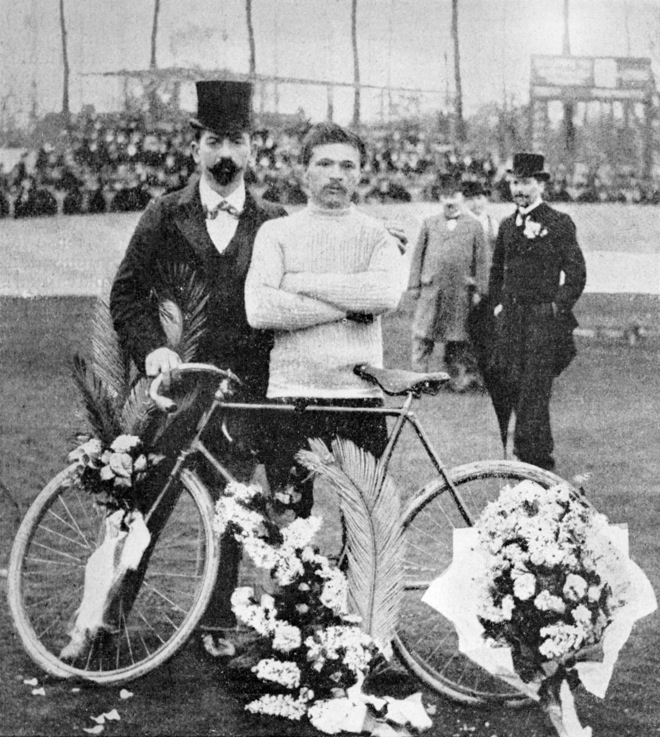





GARIN v BSA 1st PATTERN ‘Y’ CHAINWHEEL

The chainwheel on this bicycle is interesting, in that it has the appearance of the BSA Fittings First Pattern ‘Y’ chainwheel, which was very popular worldwide at the time. However, if you look more closely you can see that it’s not a detachable BSA chainwheel, but a cheap local copy trading on the design of the BSA item.
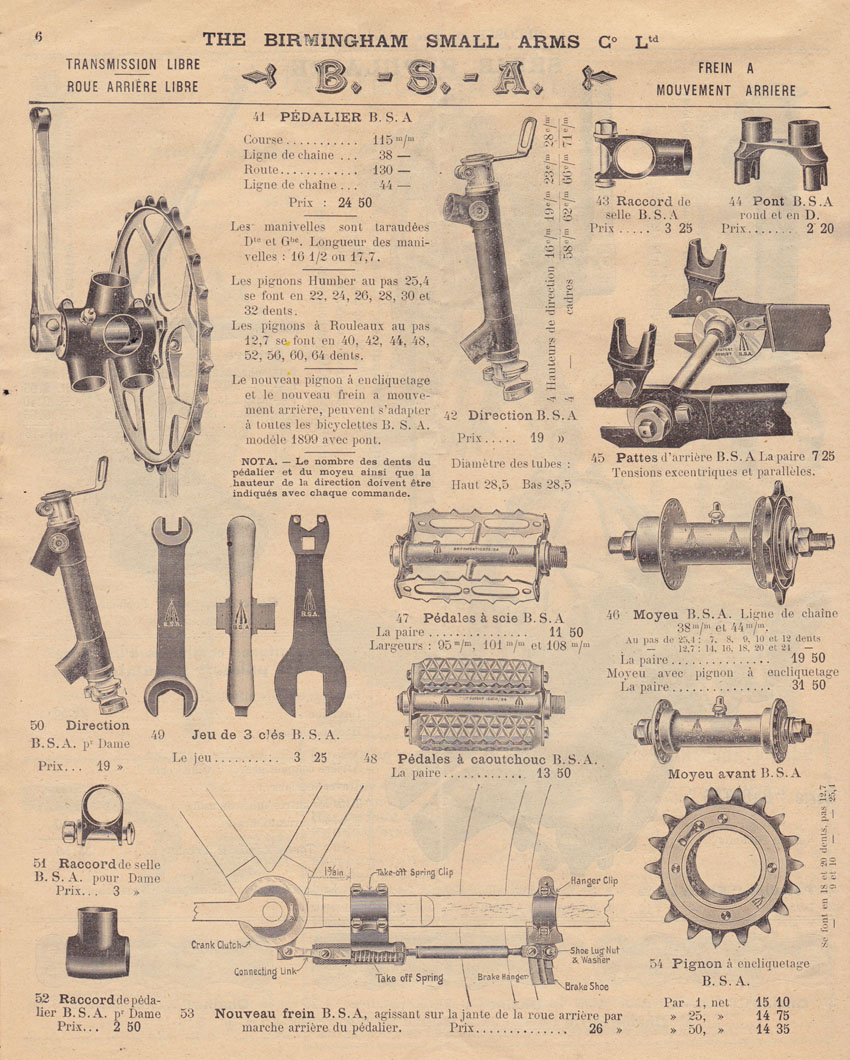
TO SEE MORE OF THE
1900 BSA FRENCH CATALOGUE
PLEASE CLICK HERE
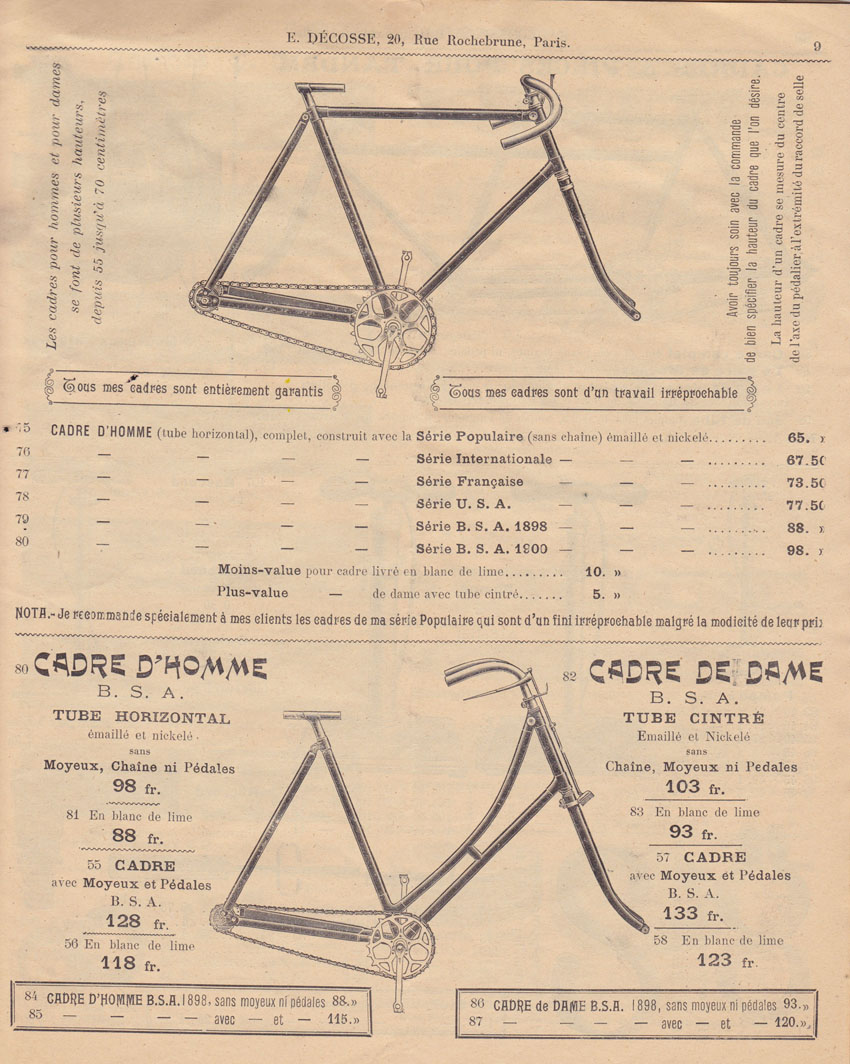

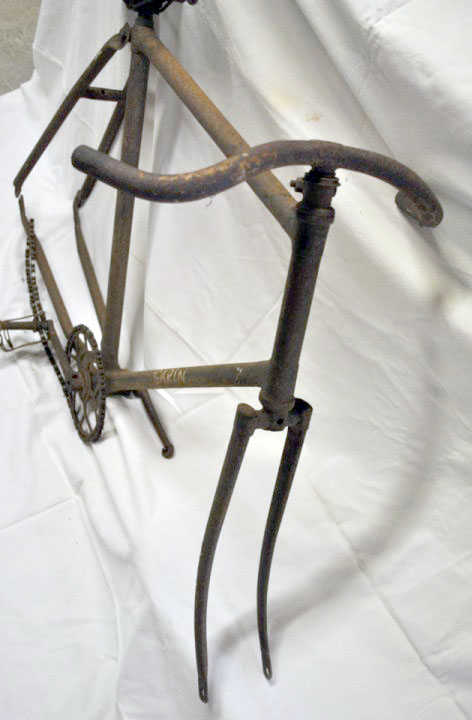

Maurice Garin info thanks to – http://en.wikipedia.org/wiki/Maurice_Garin
http://publicdomainreview.org/collections/the-first-tour-de-france-1903/



















